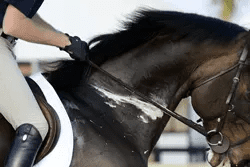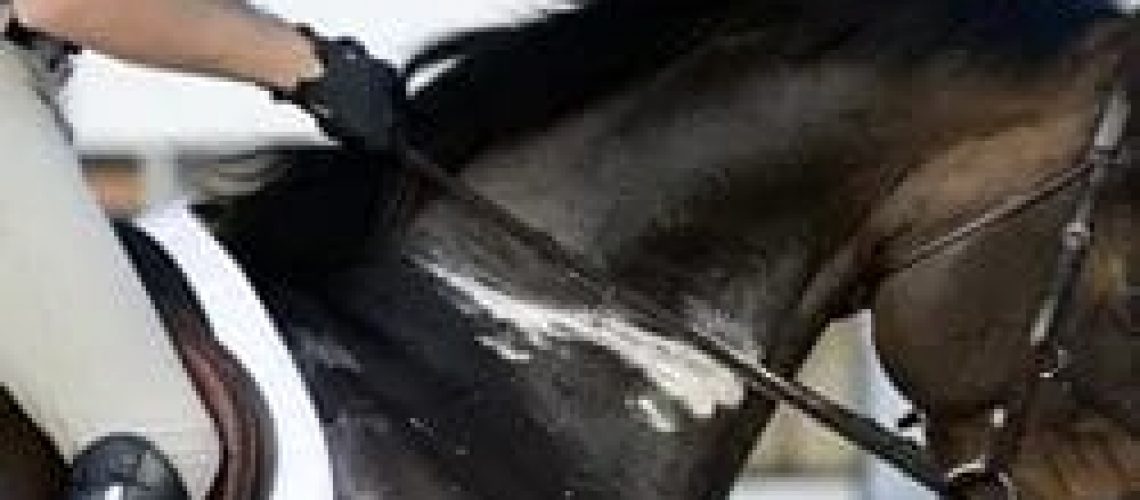
I’m a certified personal trainer. I push myself to work out pretty hard to stay as fit as possible for not just my riding, but for my health as age inexorably presses on me. I know how it feels when muscles are burning, are so fatigued that they are trembling, and when I just can’t get enough oxygen in my lungs and I have to stop and take a break. I know these feelings very, very well. They aren’t my favorite feelings, let me tell you! So when I see the physical fatigue or exhaustion symptoms in a horse, I go straight to empathy. And yet, I see riders and trainers ride their horses to or even past exhaustion or muscle failure day after day, without seeming to have any awareness of what their horses are experiencing.
The often quoted classical wisdom is to “ride your horse to the limit but not over.” Now, that can be interpreted as their physical limit, mental limit, or training limit, but the point is to not push the horse over whatever limits they might have. And yet from a fitness perspective, pushing yourself past your limits is what demands your body to make changes and get stronger, faster, fitter – growth comes from pushing out of your comfort zone. It’s no different for a horse. If you want your horse to become stronger, faster, fitter, or able to handle more mental pressure, they have to be challenged.
We know from extensive scientific studies of equine movement and biomechanics that a horse will work past its physical limits when induced to by the rider. As a result, when muscles reach failure limits, the stress of movement and weight is transferred to their tendons and ligaments. Interestingly, they can also continue past their normal lung capacity, and even have a special air pouch in their heads that allows them to function with body temperatures so high it would damage their brains by cooling the overheated blood before it reaches their brains. This ability to perform past normal physical limits is why the horse has survived for thousands of years running from predators. If they had to stop to take a breather when they got tired, they would likely be dinner. Furthermore, if they show weakness they are likely to become dinner, so hiding their actual state of exhaustion is yet another survival mechanism. Fortunately for us, their bodies have adapted to function beyond normal tolerances and survive as a species. However, if they are pushed beyond those tolerances on a daily basis, it only makes sense that structural failure will ultimately occur. And once structural failure occurs, we end up with horses in rehab and not in training.
It is in our, and our horses’ best interest to follow that age old advice of not pushing beyond their limits. But, how much is enough. And how much is too much? And since they can’t talk to us, how in the world do we know if we’ve reached the limit or not?
The reality is that we can never know with 100% assurance where on the scale of limits we are with our horse on any given day. They *can’t* talk, so all we can do is observe their body language, and without the right understanding of that body language, we are likely to miss all the subtle signs they try to hide in order to stay safe. This leads many equestrians to being afraid to ever actually challenge their horses, and as a result they never see the kind of physical development or training progress their horses are capable of. This challenge leads other equestrians to give up trying to figure it out and simply hand that judgment over to their trainers, assuming that the trainer will know how much is enough or too much and prevent them from going over the limit. Yet others simply don’t want to think about it, and just ride however they feel like riding that day. I prefer to believe that these people are simply ignorant of their impact on the horse, and if they knew better they would do better, but sadly, that may sometimes be wishful thinking on my part.
As it is, I prefer to believe that most horse owners/riders/trainers WANT to know how to train and condition their horses to the limit and not beyond. I want to believe that we can all learn how to judge those limits for ourselves, and adhere to careful conditioning and training programs that work with the horse’s body instead of against it. Because I choose believe this of my students and clients, and because I feel the responsibility to be a voice for the horse that has none, I do my very best to point out those little subtle signs and signals the horse does present to us. I help those horses’ owners learn how to interpret the signals their horses are giving them, and plan training programs that take those into account. But how can the average horse owner or rider learn these things without someone to point them out? Well, I’m here to help…
Making sure your horse is not in pain is always the first place we should start whenever we contemplate a fitness or training program for him or her. This means having a veterinarian check for any structural issues, having a saddle fitter ensure that your saddle fits as well as it possibly can, and it means making sure that all the equipment, strap goods, boots, etc, is not rubbing, chafing or otherwise causing your horse misery. Just like you might go get a good pair of tennis shoes and some well-fitted sports bras when you start a new workout, your horse needs to be well-equipped for his fitness training. It is my humble opinion that *any* training you do with a horse that is in pain is over the limit. So doing everything you can to ensure your horse’s comfort is always the first place to start.
Now, we’ve already established that physical conditioning is a result of pushing physical limits. So how do we do that with our horses in a safe way, that doesn’t result in them breaking down or hating their work? It takes years of experience to strike this balance with our horses, so allow yourself the grace to make mistakes. It’s the only way you’ll learn, and a few mistakes won’t kill your horse. Not learning the lessons you can learn from those mistakes might. In the meantime, here are the guidelines I follow when I take a horse in training:
- When in doubt, ask for a little bit less than your horse’s maximum effort. This often results in a slightly slower path to fitness or competition goals, in truth. But, I have never regretted going a little slower than is absolutely necessary. I have, however, regretted trying to go faster than I should have. That’s one of those lessons that is hard learned.
- Periodically, test your horse’s limits. You’ll never know where they are if you don’t occasionally push past them. I do this every couple of months to see how my horse’s physical and mental limits are changing. The horse’s body and mind will forgive the occasional over-the-limit workout, and it’s critical to get a sense of this for yourself, so allow yourself to find the limits every now and again.
- Alternate harder work days with easier ones. If you push the limits one day, go for a hack the next day. Maybe give him two light days as a recovery period, before going back to your regular work program.
- Never do the same exercises more than two days in a row. There is often a distinct benefit to trying something new one day, and then doing it again the next day to see how the lesson was received. Did the horse learn that thing? Are they confident and willing the next day, or were they confused and rattled, and need more clarification or to take a step back and break it down a little more? Sometimes it’s extremely helpful to be patient enough to only make partial headway one day, and follow up the second day to really complete the lesson. I rarely find doing the same for a third day to be helpful. Especially if the exercise requires new muscles. By day 3, they will be well and truly sore, so move on to something else for a day or two.
- Vary your horse’s training program. Carl Hester is now famous for sharing how he and Charlotte Dujardin only ever train their horses in the arena 4 days out of each week. The other 3 days they do something completely different. Hacking out, work over cavaletti or jumps, “interval” training for cardiovascular development, and work up and down hills are all excellent supplemental exercises that will not only keep your horse mentally fresh, but will strengthen his body beyond what the arena work requires of them. That can only make the time they spend in the arena more pleasant.
- Reward the try. If you ask your horse to do something difficult, new, or something he’s not very good at, don’t harp on it until it’s perfect. You can easily go over the horse’s physical limit just by not being happy with his best effort that day.
- Quit when it’s good. The best reward for your horse is for you to get off and take him back to his stall when he’s done the right thing. If you start your horse’s workout, and he does absolutely everything you’ve asked to the best of his ability in the first 20 minutes, get off. There’s no need to drill. Maybe tomorrow you push a little, but give your horse the credit he’s due, and let him feel good about himself when he’s being a super star.
Ok, so those are some good general principles to follow in your training and conditioning program, but what are the telltale signs that your horse is reaching his limit, or has gone over it on a day to day basis? Here are some things to keep an eye out for, and adjust your training session accordingly:
- Anxiety – some horses are anxious by nature, but most can be brought to relaxation through a training session. So if your horse is generally relaxed and starts to exhibit signs of anxiety, that can be a really big clue that they are stressed physically or mentally, and could probably use a break because you’re pushing a limit for that horse at that moment. Anxiety can show up as chomping on the bit, grinding teeth, spooking, getting “hot” or reactive, or even calling to other horses. Many people don’t realize that calling is a sign of anxiety, but it is the horse attempting to reach out for the security of the herd. Recognize it as a sign that your horse is anxious, and maybe give him an extra bit of encouragement or do something a little easier until he relaxes.
- Trembling or twitching muscles. You can see this most obviously in the horse’s neck. If you halt your horse on the bit and notice his neck muscles trembling or twitching, take that as a sign that your horse’s neck muscles are in a state of fatigue. Give him a few minutes on a loose rein to relax and stretch those muscles before asking him to continue. The neck isn’t the only place you can see this, though. If the horse is extremely fatigued, you might see trembling in the hindquarters as well. I will never forget the little young miniature horse that I used to watch a driven lesson with his owner once a week, and by the end of each lesson he would be standing there with his poor little hind legs positively trembling. It hurt my heart to see that poor little young horse in such an extreme state of fatigue. That’s just too far past the limit in my opinion.
- Elevated respiration for too long after cessation of work. It is generally acknowledged that the guideline for cardiovascular fitness is that a horse will recover his breath within two minutes of rest after work. That means that if your horse is breathing hard with the work and you go to walk, within two minutes your horse should take a deep recovery breath and start breathing normally. If it takes longer than 2 minutes for him to take that deep recovery breath, you are pushing beyond your horse’s cardiovascular limits. Keep your work segments shorter between walk breaks. Keeping track of your horse’s breathing recovery rates will give you good indications of improvements in his fitness.
- Slowing down or losing energy is a clear sign that you’re approaching your horse’s limit. I’ve heard people say “Oops, my quarter ran out!” when their horse seems to hit a wall and suddenly, sometimes dramatically seems to run out of energy like a supermarket mechanical horse powering down. This is a very clear signal that you’re rubbing up against your horse’s limits. When a horse has such an obvious signal, you are lucky! There’s no ambiguity there. You know exactly how much you need to push to help the horse reach the next level of fitness, which is exactly where we want to be.
However, some horses simply quit or give up and stop trying at all when they reach that limit. My philosophy is that I don’t walk away from my personal trainer and leave the gym when I get tired in the middle of a workout, so the horse doesn’t get to ignore me and leave the arena just because he reached that fatigue point. I will acknowledge that we’ve reached the limit, and if we are in the middle of the ride when that happens, I may choose one of several options – 1) if this is the struggle point, that is when change happens, so I may give the horse a short break and then ask it to try whatever the exercise was when they hit the wall “one more time” with their best effort, and then make a big fuss over them and quit. 2) if the horse was doing everything super well when it hit that wall, I may just take a quick hack and end the session, or 3) depending on the exercise we were working on, I may do that same exercise a bit longer or change the exercise, but do in the walk. Walk is always easier for the horse, and if you haven’t quite gotten to a quitting point, it’s a great option to get to that point without further fatiguing your horse. I once was riding a client’s lovely horse who was absolutely killing it for the first part of the ride. She was doing everything I asked, and when we came to a moment of halt, she turned her head around and put her nose on my boot. She was clearly letting me know that she had reached her limit. She didn’t quit in the middle of an exercise, but gave her best efforts right up to that point, so out of appreciation for her efforts and acknowledgement of her very polite way of letting me know she was at her limit, I simply got off and let her be done. - If your horse says “No”, that’s a very clear sign that you’ve gone past a limit. If you’re training your horse and they are struggling with something, but you keep pushing until the horse explodes into rearing or bucking or some other refusal, that is a pretty clear “No” coming from your horse. This is different from the young horse that decides he doesn’t want your leg on him and bucks every time you ask for a canter. It’s different from a horse that gets confused and starts throwing things out there in hopes of hitting on the thing you’re asking him for. It’s also different from the dominant horse who thinks it can make you back down by threatening to be naughty whenever you ask for something harder than walking around on a loose rein (mare owners, you know what I’m talking about…). It’s the horse being willing to go to the mat with you and fight because it can’t see any other option. Horses are prey animals, with flight being their preferred option to get away from danger. So when they feel like they are cornered to the point that they are willing to fight, you’ve way overreached a limit, and many times the horse will become dangerous if you don’t change something immediately. Now, it may be a physical limit you’ve hit, or it may be a mental one. Either way, it’s time to back up, try something different, or simply come at the same problem from a completely different angle. The larger your box of training tools, the easier it is to avoid bumping up against this type of limit.
I really believe that having the respect for our horses to treat them the way we’d like to be treated as athletes is important, and when it comes to physical conditioning, empathy is critical. They aren’t people, and in many ways they deal with physical exercise differently than we do, but they deserve our willingness to learn their “tells” and be fair in our expectations of them on a daily basis. If we proceed this way with training and conditioning our horses, we are more likely to be successful in achieving the goals we set for them and ourselves, and for them to be content in the jobs we have chosen for them.

